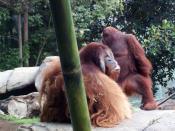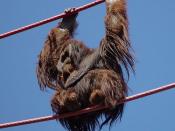When I visited the San Diego Zoo, one of favorite exhibitions is the orangutan exhibit and watch these amazing and charismatic apes. Always aware that they are in the presence of humans, whether it is the youngsters swinging deftly on their ropes and climbing structures, or the adults having staring matches with the humans on the other side of the viewing glass.
Orangutans are in the class pongo pygmaeus and are one of the four great apes. They walk on the palms of their hands similar to how human infants crawl but they cant travel rapidly in this fashion too long. This quadrupedal locomotion is so tiring to the primates that they will start to somersault to their destination. The only way that Orangutans can travel long distances without exhausting themselves are by means of using trees. At the San Diego Zoo, instead of trees they had man made structures.
The orangutans destroy the trees so the zoo had to invent something that would endure their ruff activities.
Orangutans engage in human like activities like face-to-face copulation, comprehension of speech, tool manufacturing and imitation. Orangutans are similar to Gorillas in the area of intelligence and communication. These similarities are due to their common ancestry. They both also use gestural communication. Gorillas and Orangutan males posses the largest canines and display the lowest degree of male-male bonding, and have the highest degree of competition for females.
Orangutans are omnivores, which means they eat a variety of meat and plants. They primarily eat fruit, leaves and small animals. However, 70% of an orangutan diet is fruit. The Durban fruit is a juicy but smelly, cantaloupe-like substance that is among one of the orangutan's favorites. They also eat flowers, bark, nuts and small insects such as termites and butterfly larva. Adult...


